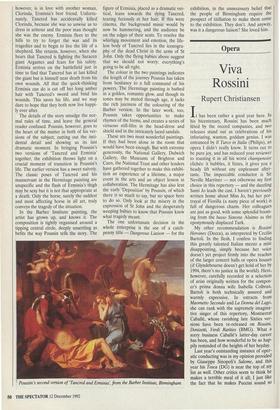Exhibitions 1
Nicholas Poussin: Tancred and Erminia (Birmingham City Museum and Art Gallery, till 3 January)
Love feast
James Hamilton
Perhaps the greatest wall of paintings in any temporary exhibition in Europe is now on show in Birmingham. For the first time, nine paintings by Nicholas Poussin have been brought together from France, Russia and Britain to illuminate a story of the con- stancy of love in the war-ravaged Middle East. This is an eternal theme, one which skips across the centuries, increasing in power and relevance as it goes: the story of Tancred and Erminia took place during the First Crusade in the 11th century; it was written by Tasso in the 16th, painted by Poussin in Roman costume in the 17th, and shown now in Birmingham in the 20th. What is more, Tancred is a Christian and Erminia a Muslim. As war rages in Yugoslavia and peace has not yet come to the Middle East, collaborative exhibitions of this quality are a sign of hope when gov- ernments fail to agree.
The collaboration has grown through the efforts of Professor Richard Verdi of the University of Birmingham and Jane Far- rington of the city's Museum and Art Gallery, two curators who took the oppor- tunities presented to them by the new spirit of agreement that has been developed between Russian and European galleries following the end of the Cold War. By unit- ing Poussin's first version of `Tancred and Erminia' (1630-31) from the Hermitage in St Petersburg, with the version in Birming- ham's Barber Institute painted two or three years later, Verdi and Farrington have shown that boldness and initiative are still alive in the Midlands.
To cut a long story short, Erminia is a Saracen princess who falls secretly in love with a Christian knight, Tancred. Tancred, however, is in love with another woman, Clorinda, Erminia's best friend. Unfortu- nately, Tancred has accidentally killed Clorinda, because she was so unwise as to dress in armour and the poor man thought she was the enemy. Erminia flees to the hills to try to forget the war and its tragedies and to begin to live the life of a shepherd. She returns, however, when she hears that Tancred is fighting the Saracen giant Argantes and fears for his safety. Erminia arrives on the battlefield just in time to find that Tancred has at last killed the giant but is himself near death from his own wounds. All that the quick-thinking Erminia can do is cut off her long amber hair with Tancred's sword and bind his wounds. This saves his life, and we may dare to hope that they both now live happi- ly ever after.
The details of the story smudge the nor- mal rules of time, and leave the general reader confused. Poussin, however, goes to the heart of the matter in both of his ver- sions of the subject, cutting out the inci- dental detail and showing us its last dramatic moment. In bringing Poussin's two versions of `Tancred and Erminia' together, the exhibition throws light on a crucial moment of transition in Poussin's life. The earlier version has a sweet naivety. The classic poses of Tancred and his manservant in the Hermitage painting are unspecific and the flash of Erminia's thigh may be sexy but it is not that appropriate at a death. Only the horse, surely the saddest and most affecting horse in all art, truly conveys the tragedy of the situation.
In the Barber Institute painting, the artist has grown up, and knows it. The composition is tightly organised around a tipping central circle, deeply unsettling as befits the way Poussin tells the story. The figure of Erminia, placed as a dramatic ver- tical, leans towards the dying Tancred, tearing furiously at her hair. If this were cinema, the background music would by now be hammering, and the audience be on the edges of their seats. To resolve the whirligig movement and emotion, the life less body of Tancred lies in the iconogra- phy of the dead Christ in the arms of St John. Only the flying babies above suggest that we should not worry: everything's going to be all right.
The colour in the two paintings indicates the length of the journey Poussin has taken from hesitancy to a full command of his powers. The Hermitage painting is bathed in a golden, romantic glow, and though its tones may be muted through age, it lacks the rich juiciness of the colouring of the Barber version. In the later work, too, Poussin takes opportunities to make rhymes of the forms, and creates a series of virtuoso still-lifer in the head-dress and shield and in the intricately laced sandals. These are two most wonderful paintings. If they had been alone in the room that would have been enough. But with extreme generosity, the National Gallery, Dulwich Gallery, the Museums of Brighton and Caen, the National Trust and other lenders have gathered together to make this exhibi- tion an experience of a lifetime, a major event in the arts and an object lesson in collaboration. The Hermitage has also lent the early 'Deposition' by Poussin, of which there is so much to say, but no space here to do so. Only look at the misery in the expression of St John and the desperately weeping babies to know that Poussin knew what tragedy meant.
The one unfortunate decision in the whole enterprise is the use of a catch- penny title — Dangerous Liaison — for the Poussin's second version of Tancred and Errninia, from the Barber Institute, Birmingham
exhibition, in the unnecessary belief that the people of Birmingham require the prospect of titillation to make them come to the exhibition. They don't. And anyway, was it a dangerous liaison? She loved him.



































































 Previous page
Previous page